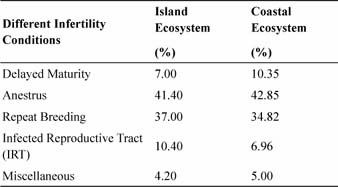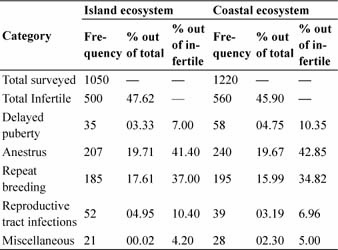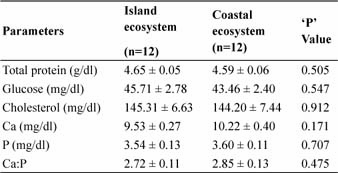
Journal of Animal Research: v.10 n.2, p. 275-279. April 2020
DOI: 10.30954/2277-940X.02.2020.16
Comparison of Serum Biochemical and Mineral Profiles of Cattle Reared Under Island and Coastal Ecosystem
ABSTRACT
The present study was conducted in the Department of Animal Reproduction Gynaecology and Obstetrics, College of Veterinary Science and Animal Husbandry, OUAT, BBSR in collaboration with ICAR-Central Island Agricultural Research Institute, Portblair (Andaman and Nicobar Island). Crossbred cattle with the history of anoestrus and repeat breeding were considered for the present investigation. The basic difference in serum biochemical and mineral profiles of cattle reared under two quite different ecosystems namely Island and coastal ecosystem was estimated which might be due to the variability in rainfall, ambient temperature, day light length and humidity. The incidence of different infertility conditions in both the ecosystems also might vary as per the environment. Serum samples were collected for estimations of biochemical parameters like total protein, glucose, cholesterol, Ca, P and Ca:P ratio. The overall incidence of infertility was recorded to be 47.62 % in island and 45.90 % in coastal ecosystem. No significant difference in serum levels of total protein, glucose, cholesterol, zinc, copper and manganese could be observed in between cattle reared in both ecosystems. It was concluded that the variations in humidity, ambient temperature, rain fall and day light length between Portblair, Andaman and coastal climate of Odisha, did not have much effect on reproduction of cattle.
Keywords: Biochemical profile, cattle, costal ecosystem, island, mineral profile
Conception rate of dairy cows may drop 20-27 % in summer and heat stressed cows often have poor expression of oestrus due to reduced oestradiol secretion from the dominant follicle, developed in a low luteinizing hormone environment (Naqvi et al.,2012). Reproductive inefficiency due to heat stress involves changes in ovarian function and embryonic development by reducing the competence of oocyte to be fertilized and the resulting embryo (Naqvi et al.,2012). The concentrations of total protein, albumin in summer may be higher than winter, where as the concentrations of glucose, cholesterol, calcium can be lower in summer than winter. The fertility rate of high yielding dairy cows is lowered during summer and even remains lower during autumn as compared to winter. It is a well known fact that, lactating cows are more adversely affected than heifers (Takahashi, 2012), due to their much greater internal heat production. Maximum environmental temperature on the day after insemination was associated negatively with conception rates (Nabenishi et al.,2011). Exposure of cattle to elevated temperatures during oocyte maturation and ovulation (Putney et al., 1989) or during the first 3 or 7 day of pregnancy, decreased embryonic viability and development (Hansen, 2013). Heat stress has been reported to alter follicular development by reducing steroid hormone production (Wilson et al., 1998) and these changes in follicular steroid concentration could disrupt oocyte growth. In addition, heat stress reduces growth of the dominant follicle and causes incomplete dominance so that there is increased growth of subordinate follicles (Bajagai, 2011). Two different and contrasting environments like island ecoculture of Andaman and costal area of Odisha differ very much in their topography and climate. Similarly, the availability of forage and mineral status of soil/ forage also greatly differ from each other. These factors might have an effect in prevalence of different infertility conditions and reproductive status of cattle through an altered serum biochemical and mineral profiles of animals. With this picture in mind, this experiment was conducted to compare the serum biochemical and mineral profiles of cattle reared under two entirely different ecosystems viz. island and costal.
How to cite this article: Chaurasia, D.K., Barik, A.K., Mishra, P.C., Biswal, S.S., Perumal, P. and Sathapathy, S. (2020). Comparison of serum biochemical and mineral profiles of cattle reared under island and coastal ecosystem. J. Anim. Res.,10(2): 275-279.
MATERIALS AND METHODS
The present study was conducted in the Department of Animal Reproduction Gynaecology and Obstetrics, College of Veterinary Science and Animal Husbandry, OUAT, BBSR in collaboration with ICAR-Central Island Agricultural Research Institute, Portblair (Andaman and Nicobar Island). Crossbred cattle with the history of anoestrus and repeat breeding were considered for the present investigation. The contour, consistency, tonicity and the patency of the cervix and uterine horns were assessed by careful manipulation and handling. The ovaries were palpated gently after retracting the cervix and uterus, cranio-ventral and slightly lateral to the bifurcation of uterine horns. When cradled between middle and index finger, the surface of the ovary was explored.
A total of 500 cattle in island (Andaman & Nicobar) eco-culture and 560 cattle in coastal climate (Odisha) were surveyed for presence of different infertility conditions.
Table 1: Percentage of different Infertility Conditions in cattle reared in two different agro-climatic regions

The meteorological data such as rainfall, maximum, and minimum temperature and humidity were collected pertaining to both the ecosystems. Twenty four cattle (12 each for anestrus and repeat breeding category) from island area and 24 cattle (12 each for anestrus and repeat breeding category) from coastal area were estimated for serum biochemical and mineral profiles (Glucose, total protein, cholesterol, calcium and phosphorus). The animals were grouped as Anestrus (Island), repeat breeding (Island) and Anestrus (Coastal), repeat breeding (Coastal).All the data generated in the above experiments were statistically analyzed using SPSS (1996) computer package. Charts were done with the help of Data analysis tool of Office 2010 of Microsoft in the computer.
RESULTS AND DISCUSSION
In the present investigation the incidence of various reproductive disorders in cows in both island and coastal ecosystem have been scrutinized from clinical data sheets and was presented in Table 2.
Table 2: Prevalence of different infertility conditions in cattle in Island and coastal ecosystems

The different biochemical parameters of anestrus cattle reared under both coastal and island ecosystem were depicted in Table 3. The mean total protein (g/dl) level was 4.65 ± 0.05 in case of island cattle where as in case of coastal cattle it was 4.59 ± 0.06. The mean glucose (mg/dl) value was recorded as 45.71 ± 2.78 for island cattle which was 43.46 ± 2.40 in coastal cattle. The mean cholesterol concentration (mg/dl) for island and coastal cattle was 145.31 ± 6.63 and 144.20 ± 7.44 respectively. The mean Ca value (mg/dl) was recorded to be 9.53 ± 0.27 in case of island cattle, where as it was 10.22 ± 0.40 for cattle reared under coastal ecosystem. The mean phosphorus concentration (mg/dl) was 3.54 ± 0.13 in case of island cattle where as it was 3.60 ± 0.11 for coastal cattle. The mean Ca:P ratio for island and coastal cattle was 2.72 ± 0.11 and 2.85 ± 0.13 respectively.
Statistical analysis of the data revealed that there was no significant difference in the values of total protein, glucose, cholesterol, Ca, P and Ca:P ratio between the cattle of both coastal and island ecosystem.
Table 3: Concentration of different blood biochemical parameters in anestrus cows reared under different ecosystems

The different biochemical parameters of repeat breeding cattle reared under both coastal and island ecosystem were depicted in Table 4.
Statistical analysis of the data showed that there was no significant difference in the values of total protein, glucose, cholesterol, Ca, P and Ca:P ratio between the cattle of both coastal and island ecosystem.
Table 4: Concentration of different blood biochemical parameters in repeat breeding cows reared under different ecosystems

The mineral profile of anestrus cattle reared under different ecosystems were depicted in Table 5. The mean Copper (ppm) for anestrus cattle reared under island ecosystem was 0.04 ± 0.005 and for coastal cattle was 0.02 ± 0.004. The mean Manganese (ppm) values recorded were 0.031 ± 0.007 in case of island cattle and 0.024 ± 0.003 for coastal cattle. The mean Zinc (ppm) value in case of island and coastal cattle was 0.33 ± 0.11 and 0.33 ± 0.07 respectively. Statistical analysis of the data revealed that there was no significant difference in the values of Copper, Manganese and Zinc between the cattle of both coastal and island ecosystem.
The mineral profiles of repeat breeder cattle reared under different ecosystems were depicted in Table 5. The mean Copper (ppm) for repeat breeder cattle reared under island ecosystem was 0.05 ± 0.006 and for coastal cattle was 0.03 ± 0.005. The mean Manganese (ppm) values recorded were 0.023 ± 0.005 in case of island cattle and 0.021 ± 0.004 for coastal cattle. The mean Zinc (ppm) value in case of island and coastal cattle was 0.33 ± 0.12 and 0.32 ± 0.09 respectively. Statistical analysis of the data revealed that there was no significant difference in the values of Copper, Manganese and Zinc between the cattle of both coastal and island ecosystem.
Table 5: Micro mineral profile of anestrus and repeat breeding cows reared under different ecosystems

In coastal ecosystem, the incidence (Table 2) of delayed puberty, anestrus, repeat breeding, reproductive tract infections and miscellaneous causes were found to be 4.75%, 19.67 %, 15.99 %, 3.19 % and 2.30 % respectively with overall infertility rate of 45.90 %. The incidence as observed in present observation corroborates the report of Sreenivas et al.(1997) and Ray et al. (2004). The mean total protein level (Table 3) in the present study is 4.65 and 4.59 (g/dl) in island and Coastal cattle respectively. The present level of total protein is comparable with the finding of Parida (2015). There is not much difference that exists between cattle reared in island and coastal ecosystems.
The mean glucose value in both island and coastal cattle during the present study was found to be 45.71 and 43.46 (mg/dl) respectively. The glucose concentration observed in the study is in partial agreement with the finding of Cetin et al. (2002). Further, quick glucolysis, the estimation may be erroneous if delayed. In blood protozoan infestation, there is low glucose level in blood. The mean cholesterol concentrations in both island and coastal cattle were found to be 145.31 and 144.20 (mg/dl) respectively. The present findings of cholesterol in island and coastal ecosystem were comparable with (Muneer et al., 2013).
The level of Ca and P in cattle of island ecosystem was found to be 9.53 and 3.54 (mg/dl), whereas in coastal ecosystem, the values were 8.22 and 3.60 (mg/dl) respectively. The present value of Ca and P corroborates the finding of Ramakrishna (1997). The Ca:P in cattle of island and coastal ecosystems were found to be 2.72 and 2.85 respectively which is within physiological limit (Kaneko and Cornelius, 1970). Statistical analysis revealed no significant difference between cattle of island and coastal ecosystem. The mean total protein level in repeaters (Table 4) was observed to be 4.50 and 4.55 (g/dl) in island and Coastal cattle respectively. The value of total protein in island and coastal ecosystem is nearly similar, which is very low as compared to findings of Cetin et al. (2002) and Widayati et al.(2018). The low serum total protein level might be due to deficiency of certain amino acids, essential for gonadotropins and gonadal hormone synthesis, resulting in hormonal imbalance and disrupted ovarian function. Through hormonal disruption, low serum protein level can have a severe impact on reproduction, resulting in silent heat, anestrus, repeat breeding, early embryonic death, absorption of the embryo by the uterine wall and the birth of a weak foetus. (Widayati et al.,2018)
The mean glucose value in both island and coastal cattle found to be 44.37 mg/dl and 45.99 mg/dl respectively. The finding of glucose at the present study corroborates with the finding of (Widayati et al.,2018). Low levels of blood glucose were indicative of a scarce energy level and inhibited GnRH secretion. It blocks follicular development and ovulation, which might result in anovulation and anestrus as well as the inhibition of estrogen and progesterone secretion which lead to repeat breeding (Prihatno et al.,2013; Butler et al.,1989). The mean cholesterol concentration in both island and coastal cattle was found to be 13.00 and 146.57 (mg/dl) respectively. The finding of cholesterol level in the study corroborates the finding of Widayati et al. (2018), whereas Guzel et al.(2014) found the lower value of cholesterol in repeat breeding cows. The level of Ca in cattle of island and coastal ecosystem found to be 9.45 mg/dl and 9.88 mg/dl respectively. The present finding of Ca was in accordance with Ramakrishna (1997) who reported that Ca appears to affect reproduction indirectly in animals. Its influence on certain enzyme system may be mediated via disruption of reproductive efficiency.
The serum concentration of zinc (Table 5) during the present study (0.32 to 0.33 ppm) was against a normal range of 0.8-1.2 ppm which speaks of a mild deficiency of zinc in the animals both from island and coastal ecosystems. Comparable values have been reported by Sahoo et al.(2017). The serum levels of copper (Table 5) was well within the physiological range (0.7-1.5 ppm) indicating normal copper level at pre treatment stage. The observation found the support of Sahoo et al.(2017). The serum manganese during the present study was presented in table 5, which was slightly below the normal range of 0.4 – 0.8 ppm. A comparable range of manganese level had been reported by Sahoo et al.(2017). However, lower values had also been reported by Modi et al.(2013).
CONCLUSION
The comparative study on climate, incidence of cattle infertility and serum biochemical profile between cattle reared in island ecoculture of Andaman and coastal ecoculture of Odisha revealed that the change in humidity, ambient temperature, rain fall and day light length did not have much effect on reproduction of cattle. The overall incidence of infertility was recorded to be 47.62 % in island and 45.90 % in coastal ecosystem. No significant difference in serum levels of total protein, glucose, cholesterol, zinc, copper and manganese could be observed in between cattle reared in both ecosystems.
REFERENCES
Bajagai, Y.S. 2011. Global climate change and its impacts on dairy cattle. Nep. Vet. J., 30: 2-16.
Butler, W.R. and Smith, R.D. 1989. Interrelationships between energy balance and postpartum reproductive function in dairy cattle. J. Dairy Sci., 72: 767- 783.
Cetin, M., Dogan, I., Polat, U., Yalcin, A. and Turkyilmaz, O. 2002. Blood biochemical parameters in fertile and repeat breeder cows. Indian J. Anim. Sci., 72(10) : 865-866.
Guzel, S. and Tanriverdi, M. 2014 Comparison of serum leptin, glucose, total cholesterol and total protein levels in fertile and repeat breeder cows. R. Bras. Zootec., 43(12): 643-647.
Hansen PJ. 2013. Cellular and molecular basis of therapies to ameliorate effects of heat stress on embryonic development in cattle. Anim. Reprod., 10: 322-333.
Kaneko, J.J. and Cornelius, C.E. 1970. Clinical biochemistry of domestic animals. 1st edn., Academic Press, Inc, New York.
Modi, L.C., Suthar, B.N., Chaudhari, C.F., Chaudhari, N.F., Nakhashi, H.C. and Modi, F. 2013. Trace minerals profile of blood serum and estrual mucus in repeat breeder Kankrej cows. Vet. World, 6(3): 143-146.
Muneer, S., Sadasiva Rao, K. and Solmon Raju, K.G. 2013. Serum biochemical profiles and body conditions score in crossbred cows affected with postpartum anestrus. Theriogenology Insight.,3(1): 17-20.
Nabenishi, H., Ohta, H., Nishimoto, T., Morita, T., Ashizawa, K. and Tsuzuki, Y. 2011. Effect of the temperature-humidity index on body temperature and conception rate of lactating dairy cows in southwestern Japan. J. Reprod. Dev., 57(4): 450-456.
Naqvi, S.M.K., Kumar, D., Paul, R.K. and Sejian, V. 2012. Environmental stresses and livestock reproduction. In: Environmental stress and amelioration in livestock production. Springer- VerlagGMbH publisher,Germany, pp. 97-128.
Parida. 2015. Induction of estrus in postpartum anestrus buffaloes by different hormonal protocols. Thesis submitted to Orissa University of Agriculture and Technology, Bhubaneswar, pp. 59.
Prihatno, S.A., Asmarani, K., Karja and N.W.K., Sumiarto, B. 2013. Blood biochemical profile in repeat breeding dairy cows. J. Kedokteran Hewan., 7: 29-31.
Putney, D.J., Mullins, S., Thatcher, W.W., Drost, M. and Gross, T.S. 1989. Embryonic development in superovulated dairy cattle exposed to elevated temperatures between the onset of estrus and insemination. Anim. Reprod. Sci., 19: 37–51.
Ramakrishna, K.V. 1997. Comparative studies on certain biochemical constituents of anestrus crossbred Jersey rural cows. Indian J. Anim. Reprod., 18 : 33-35.
Ray, S.K.H., Dash, H.D., Mohanty, D.N., Das, S., Bisoi, P.C. and Barik, A.K. 2004. Studies on certain haematological and biochemical constituents in cows with retained fetal membranes. Indian J. Anim. Reprod., 25: 128-130.
Sahoo, J.K., Das, S.K., Sethy, K., Mishra, S.K., Swain, R.K. and Mishra, P.C. 2017. Effect of feeding area specific mineral mixture on haemato biochemical, serum minerals and ovarian status of reproductive disordered crossbred cattle in Jatani block of Odisha. Int. J. livest. res.,7(5): 98-104.
Sreenivas, Choudri, S.C., Arali, G.S. and Honnappagol, S.S. 1997. Incidence of various reproductive disorders in cows and buffaloes of Bidar. National symposium on recent advances for enhancement of reproductive efficiency of farm animals. XIV Annual con. Natl. Symo. ISSAR, Bidar, Nov 14-16, pp. 104.
Takahashi, M. 2012. Heat stress on reproductive function and fertility in mammals. Reprod. Med. Bio., 11 (1): 37-47.
Widayati, D.T., Bintara, S., Natawihardja, I. and Maharani, D. 2018. Blood biochemical profile in fertile and repeat breeder Ongole cross breed cows. Pak. J. Bio. Sci.,21: 166-170.
Wilson, S.J., Marion, R.S., Spain, J.N., Spiers, D.E., Keisler, D.H. and Lucy, M.C. 1998. Effects of controlled heat stress on ovarian function of dairy cattle. J. Dairy Sci., 81: 2139-2144.